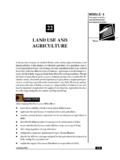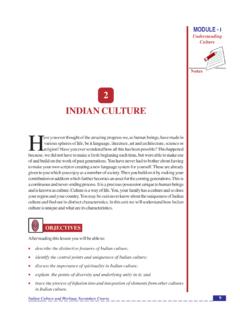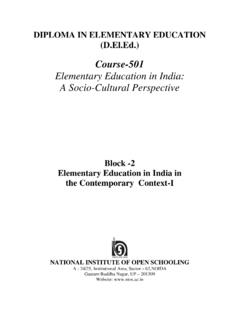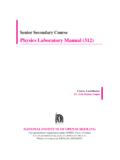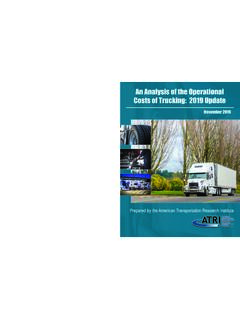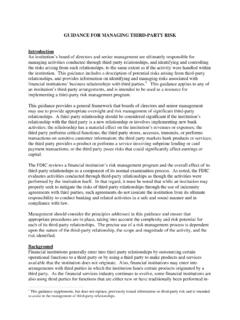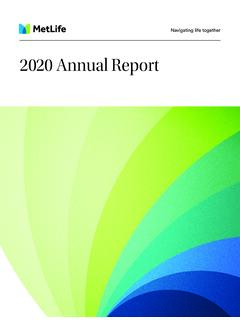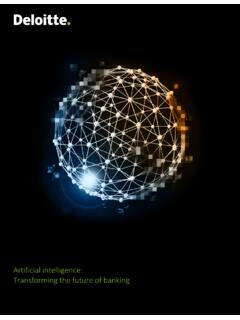Transcription of SOURCES OF LONG-TERM FINANCE - National Institute of …
1 MODULE -4 Business Finance29 Business StudiesNotesIn the previous lesson you learnt about the various methods of raising long-termfinance. Normally the methods of raising FINANCE are also termed as the SOURCES offinance. But, as a matter of fact the methods refer only to the forms in which thefunds are raised, and hence may or may not include the SOURCES from, or throughwhich the funds are raised. Hence, we must also have an idea about the SOURCES offinance. You will recall that the various SOURCES of LONG-TERM FINANCE had been dulyidentified in the previous lesson.
2 We shall now learn in detail about those studying this lesson, you will be able to: identify the various SOURCES of LONG-TERM FINANCE ; explain the meaning and importance of capital market; identify the special financial institutions in India; describe the nature and role of special financial institutions; explain the concept of mutual funds; describe the role of leasing companies; identify the foreign SOURCES of LONG-TERM FINANCE ; explain the importance of retained earnings as a source of LONG-TERM SOURCES OF LONG-TERM FINANCEThe SOURCES of LONG-TERM FINANCE refer to the institutions or agencies from, or throughwhich FINANCE for a long period can be procured.
3 As stated earlier, in case of soleproprietary concerns and partnership firms, LONG-TERM funds are generally providedby the owners themselves and by the retained profits. But, in case of companieswhose financial requirement is rather large, the following are the SOURCES from, orthrough which LONG-TERM funds are OF LONG-TERM FINANCEMODULE -4 Business FinanceSenior SecondaryNotes30(a)Capital Market(b)Special Financial Institutions(c)Mutual Funds(d)Leasing Companies(e)Foreign SOURCES (f)Retained CAPITAL MARKETC apital market refers to the organisation and the mechanism through which thecompanies, other institutions and the government raise LONG-TERM funds.
4 So itconstitutes all LONG-TERM borrowings from banks and financial institutions, borrowingsfrom foreign markets and raising of capital by issuing various securities such asshares debentures, bonds, etc. For trading of securities there are two different segmentsin capital market. One is primary market and the other is, secondary market. Theprimary market deals with new/fresh issue of securities and is, therefore, known asnew issue market. The secondary market on the other hand, provides a place forpurchase and sale of existing securities and is known as stock market or new issue market primarily consists of the arrangements, which facilitates theprocurement of LONG-TERM FINANCE by the companies in the form of shares, debenturesand bonds.
5 The companies usually issue those securities at the initial stages of theirformation and so also later on for expansion and/or modernization of their , the selling of securities is not an easy task, as the companies have to fulfillvarious legal requirements and decide upon the appropriate timing and the methodof issue. Hence, they seek assistance of various intermediaries such as merchantbankers, underwriters, stock brokers etc. to look after all these aspects. All theseintermediaries form an integral part of the primary secondary market (stock exchange) is an association or organisation or a bodyof individuals established for the purpose of assisting, regulating and controlling thebusiness of buying, selling and dealing in securities.
6 It may noted that it is called asecondary market because only the securities already issued can be traded on thefloor of the stock exchange. This market is open only to its members, most of whomare brokers acting as agents of the buyers and sellers of securities. The main functionsof this market lie in providing liquidity (ready encashment) to securities and safetyin dealings. It is because of the availability of such facilities that people are ready toinvest in securities. We shall learn more about the capital market in lesson no. SPECIAL FINANCIAL INSTITUTIONS (SFI)A number of special financial institutions have been set up by the central and stategovernments to provide LONG-TERM FINANCE to the business organisations.
7 They alsooffer support services in launching of the new enterprises and so also for expansionand modernisation of existing enterprises. Some of the important ones are IndustrialMODULE -4 Business Finance31 Business StudiesNotesFinance Corporation of India (IFCI), Industrial Investment Bank of India (IIBI),Industrial Credit and Investment Corporation of India (ICICI), Industrial DevelopmentBank of India (IDBI), Infrastructure Development FINANCE Company Ltd. (IDFC),Small Industries Development Bank of India (SIDBI), State Industrial DevelopmentCorporations (SIDCs), and State Financial Corporations (SFCs), etc.
8 Since theseinstitutions provide developmental FINANCE , they are also known as DevelopmentBanks or Development Financial Institutions (DFI). Besides these developmentbanks there are a few other financial institutions such as life Insurance Corporationof India (LIC), General Insurance Corporation of India (GIC) and Unit Trust ofIndia (UTI) which provide LONG-TERM FINANCE to companies and subscribe to theirshare and debentures. The main functions of these institutions are:(i)to grant loans for a longer period to industrial establishment;(ii)to help the establishment of business units that require large amount of fundsand have long gestation period;(iii)to provide support for the speedy development of the economy in general andbackward regions in particular;(iv)to offer specialized services operating in the areas of promotion, projectassistance, technical assistance services and training and development ofentrepreneurs.
9 (v)to provide technical and professional management services and help inidentification, evaluation and execution of new QUESTIONS between new issue market and stock exchange. (Give one point) the full form of the following abbreviation.(a)DFI_____(b)IIBI_____(c)S IDBI_____(d)SFI_____(e)IFCI_____Let us have a brief idea about some of the Special Financial FINANCE Corporation of India (IFCI): It is the oldest SFI set up in1948 with the primary objective of providing LONG-TERM and medium-term financeto large industrial enterprises. It provides financial assistance for setting up ofnew industrial enterprises and for expansion or diversification of activities.
10 Italso provides support to modernisation and renovation of plant and equipmentMODULE -4 Business FinanceSenior SecondaryNotes32in existing industrial units. It can grant loan or subscribe to debentures issuedby companies repayable in not more than 25 years. It can also guarantee loansraised from other SOURCES or debentures issued to the public, and take upunderwriting of the public issue of shares and debentures by companies. Forensuring greater flexibility to meet the needs of the changing financial systemIFCI now stands transformed to IFCI Ltd.

